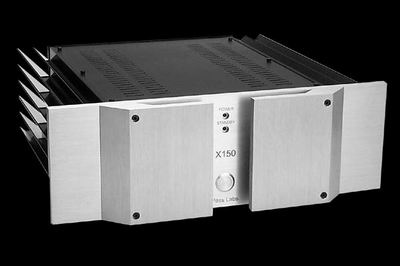Pass Labs X150 Stereo Amplifier
| Pass Labs X150 Stereo Amplifier |
|
|
|
Joe Lamano |
|
14 May 2003 |
 Specifications
Specifications
Gain: 30 db
Frequency response: -0 dB at DC, -3 dB at 100 kHz
Power Output: 150 W maximum @ 1% THD, 1kHz into 8 Ohms (300 W into 4 Ohms)
Maximum Output Voltage: +_ 50V
Maximum Output Current: +_ 20A
Input impedance: 22 kohms balanced
Slew Rate: +_ 50V/uS
Output Noise: 300 uV unweighted 20-20 kHz
Random Noise Floor: approx. 2uV
Dynamic Range: 145 db (random noise floor to peak output)
Balanced CMRR: -85 db
DC offset: <100mv
Power consumption: 200 W idle, 600 W max.
Temperature: 20 degrees C. above ambient at idle
Dimensions: 19″W × 6.5″H × 20″ D
Shipping Weight: 70lbs.
Price: $4,000
Address:
Pass Laboratories
PO Box 210
Foresthill, CA 95631
Telephone: (530) 367-3690
Website: www.passlabs.com
I first came across the Pass Labs X150 stereo amplifier during my pursuit of musical sounding amps in the $4,000 – $5,000 price range. In this range, which is considered to be “moderate” for high-end audiophile grade amplification, I found that there are many fine sounding amplifiers to choose from, each having a unique physical characteristics and sound. Initially, like many other people, I associated Pass Laboratories with their larger X series amplifiers like the X1000 and X600 monoblocks or their powerful X350 stereo amplifier. At 150 watts per channel into 8 ohms this amplifier is no slouch, but compared to its larger siblings, the X150 seems small. But after spending time with the X150, I found it to be the most underrated product in the Pass Labs product line. Although it may not have the same flashy aesthetics as some of the larger X amplifiers, or boast the same high power ratings, this amplifier has a transparent and detailed sound that is musically truthful.
The X150 embodies much of the same technology as the larger amplifiers in the series, and it closely resembles the X350. At the core of this amplifier is the patented Supersymmetry™ circuitry, which provides the fundamental technology used in the balanced design of this amplifier and claims to reduce distortion and noise by an order of magnitude over other matching techniques. From reading the design literature that is readily available from Pass on their website, I learned that for SuperSymmetry to work properly the amplifier requires a balanced input signal. Immediately I thought this design imposed a limitation on users. I decided to call the people at Pass to get a clarification on the design. They told me to support the needs of those using a single-ended connection Pass provides an internal circuit that can synthesize a balanced signal from a single-ended input. Enabling this circuitry is as simple as jumping pins 1 and 3 on the XLR input. In addition to the Supersymmetry technology, all the Pass Labs X Series amplifiers share the same basic power supply topology. I was told that any differences between the models are strictly based on the needs required to reach the desired output level. The X Series amplifiers also share the same two gain-stage philosophies, but once again the differences are based on the number of matched devices needed to produce the output wattage. So the majority of differences between the X150 and other X amplifiers are either cosmetic or exist as a matter of achieving the output wattage. The fundamental signal handling and amplification design level are the same.
The X150 exudes the build quality that Pass incorporates into all of their products. The rugged chassis has a stylish front plate made of brushed aluminum and the sides are lined with heat sinks. This amplifier’s shipping weight is approximately 70 pounds, so I was not surprised when it arrived that the delivery driver chose to make sure that someone was able to sign for the unit before lugging it to the door from his truck. The rear panel provides plenty of room for connecting large speaker cables and a removable power cord. Two large handles are affixed to the rear plate to help make moving the amp slightly easier. A small, but nice, feature that I like on the X150 is the remote triggering capability. Although I use spade connectors on my speaker cable, I did notice that banana plug connectors are not supported. I was told that Pass no longer includes the banana plug connector for safety reasons when exporting to countries that have electrical connections that can fit into ¾ inch banana plugs terminal. Also the X150 only has one pair of binding posts per channel and therefore does not support bi-wiring from the amp. Like the X series multi-channel amplifiers, the front panel contains a stand-by push-button switch and two LED status indicators. The Blue meter used to display the current bias of the output stage was intentionally left off to keep the chassis size smaller and make the unit more affordable. Although the meter provides the amplifier with a “cooler” look, it doesn’t provide any sonic benefit whatsoever. Nevertheless, one month after I received the X150 I learned that Pass was releasing a modified version of this amplifier, the x150.5, which is a slightly altered x150 that will include the current bias meter for an additional $500. I personally have not heard the 150.5, but the people at Pass told me that it is designed to have the same performance as the X150.
I began the evaluation process by connecting the X150 to a pair of Isophon Europa loudspeakers. These speakers tested the amplifier’s ability to handle a more complex speaker configuration. The Europa has a 6 Ohm impedance and consists of two 9″ bass drivers, three 4″ midrange drivers, and a 1″ tweeter. I have heard other amplifiers struggle with these speakers at high volume levels especially during strong transients, but the X150 showed no sign of weakness and performed at a level that sounded much greater than it’s stated power rating. In addition, the X150 produced the best bass response that I have heard so far from these speakers. Compared to the Majeel Pristine A-S10 amplifier I recently evaluated, the X150 provides a sound that is much more neutral and transparent compared with the warm and midrange forward sounding Majeel. The X150 also exhibited a greater ability to drive bass out of the Europas, which seem to struggle with low frequency response. But when paired with the Talon Raven-C loudspeakers, which I recently reviewed, the result was awesome. The combination of the two products produced a three-dimensional sound that was very open and had strong imaging and detail. The X150 effortlessly controlled the Ravens even as I increased the volume level.
Listening to this amplifier makes it obvious that the focus is on naturalness, clarity, and dynamics. This is not a warm, or tube-like sounding amplifier by design. It is articulate with its detail and natural sounding in its presentation, letting you focus on the music and not the equipment. In short, I didn’t find the X150 exhibited any coloration. The trio of Stephen Scott, Roy Hargrove, and Christian McBride playing Charlie Parker classics on Parker’s Mood [VERVE 314 527 907-2] allowed the X150 to demonstrate its ability to handle dynamics and reveal subtle details. Even when McBride’s stand-up bass notes were fast and kept pace with the very catchy rhythms, the Talon’s 10″ woofers were easily controlled by the X150. The sharp blasts from the horns soared from the speakers with great dynamics (very startling when you don’t expect it), but they weren’t grainy and uncomfortable. On good recordings, the X150 presented strong attack followed by clear decay into a black backdrop. Strong high frequency and midrange transients were executed with good tonal control. When listening to the softer sounding work of Norah Jones’ Come Away with Me [Blue Note BN7243] the piano and female vocal ranges exhibited good presence with honest reproduction and a relaxed setting. The X150 possesses a crisp and detailed sound without the over-extended or bright treble found on many solid-state amplifiers. The slow plucks of the bass strings are realistic, tight and deeply reproduced without sounding boomy. The X150 really demonstrated an ability to drive deep low bass. This is definitely a strong quality of this amplifier and probably why it sounds so well paired with speakers like the Talon Raven that have good low frequency extension.
To prove to myself that this amplifier is not only suited for Jazz, I listened to a re-mastered 96 kHz 24-bit recording of “L.A. Woman” [Elektra 75011-2] by The Doors. I found the sonic characteristics remained the same; very revealing, three-dimensional, and possessing a sound that is crisp. I was really impressed with the detail on “Riders on the Storm”. Besides the holographic musical reproduction, the falling rain in the background was crystal clear as if it were falling literally outside my own window. But the X150 doesn’t only require good recordings. I was pleasantly surprised to notice that it is very forgiving and open to all music genres. Old and new recordings played with consistent characteristics. Obviously better recordings will allow this amplifier to demonstrate its capabilities, but (and I hate to use the cliché) this is one of those amplifiers that allows you to hear things you have not heard before.
I think the X150 is a top performer in its price and power class. This amplifier provides plenty of power for the money, but most of all it provides a sound that is focused on the music. For people needing a darker or brighter amplifier to compensate for other equipment this is probably not the amplifier for you. But for those looking to reveal music with power and control, the X150 just may do the trick.
![]()
Don’t forget to bookmark us! (CTRL-SHFT-D)
Stereo Times Masthead
Publisher/Founder
Clement Perry
Editor
Dave Thomas
Senior Editors
Frank Alles, Mike Girardi, Russell Lichter, Terry London, Moreno Mitchell, Paul Szabady, Bill Wells, Mike Wright, and Stephen Yan,
Current Contributors
David Abramson, Tim Barrall, Dave Allison, Ron Cook, Lewis Dardick, John Hoffman, Dan Secula, Don Shaulis, Greg Simmons, Eric Teh, Greg Voth, Richard Willie, Ed Van Winkle, Rob Dockery, Richard Doron, and Daveed Turek
Site Management Clement Perry
Ad Designer: Martin Perry





Be the first to comment on: Pass Labs X150 Stereo Amplifier